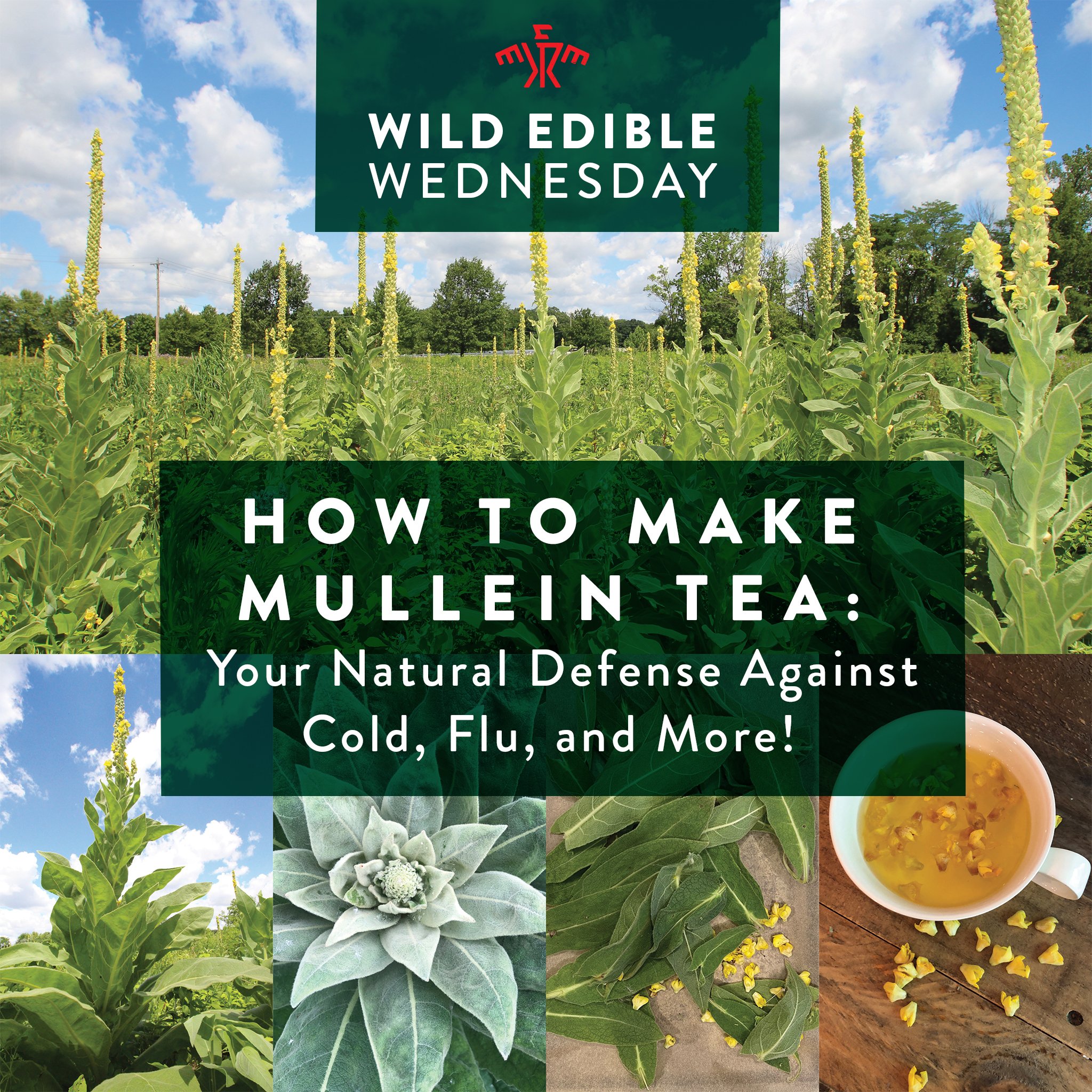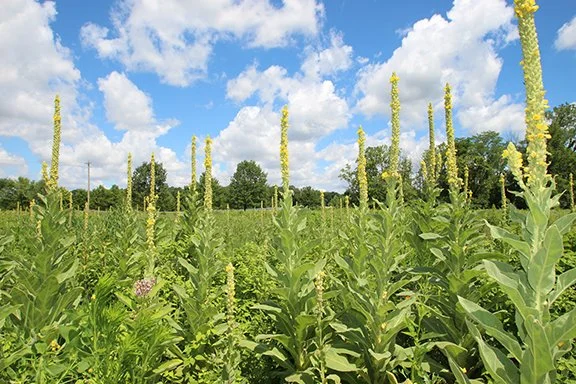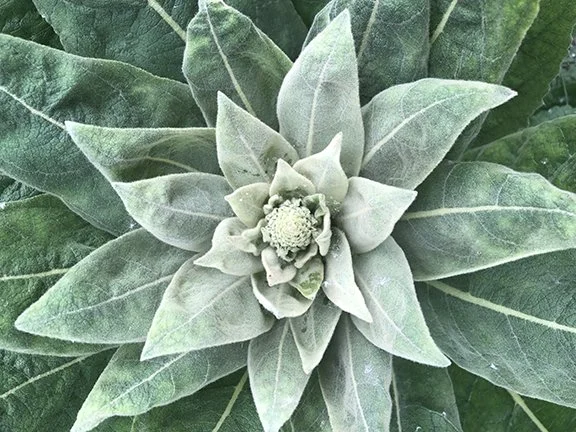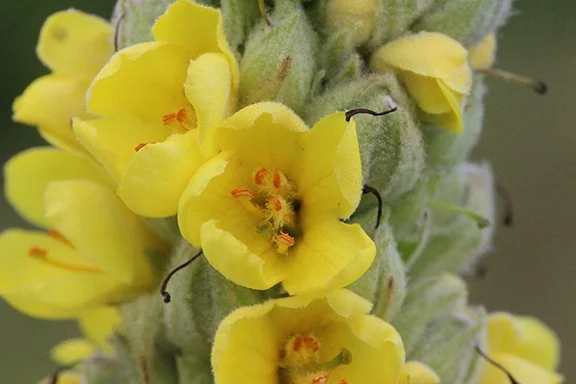How to Identify Mullein & Make Mullein Tea - Your Natural Defense Against Cold, Flu, and More!
Mullein: An Introduction
Below is a sort video of me making a healing Mullein Tea from fresh mullein leaves.
In the vast realm of herbal wonders, the unassuming Mullein (Verbascum thapsus) quietly graces our surroundings, often going unnoticed despite its towering presence. With its soft, lamb's ear-like leaves and a striking stalk of yellow flowers, Mullein has silently witnessed centuries, offering both solace and remedy to those who understood its gentle power. From the ancient Greeks to Native Americans, this biennial plant has woven itself through the tapestry of herbal lore and practice, providing relief to troubled lungs and illuminating dark nights as a makeshift torch. Today, as we navigate through the meadows or peer into the corners of abandoned fields, the Mullein stands tall, ready to share its herbal secrets with those willing to explore.
In this journey through the leaves and flowers of Mullein, we shall uncover its historical significance, delve into its medicinal properties, and guide you through identifying, harvesting, and utilizing this herbal ally in your daily life. Whether you're an experienced herbalist, a survival enthusiast, or someone embarking on a herbal discovery, Mullein has something to offer. From its ability to soothe a troubled respiratory system to lighting the way in the darkest of nights, this plant, often deemed a mere 'weed,' is a treasure trove of remedies and uses.
Identifying Mullein in the Wild
Mullein, scientifically known as Verbascum thapsus, is a plant that is not only visually striking but also packed with a rich history and numerous medicinal uses. This biennial plant, which means it completes its lifecycle in two years, is easily recognizable once you know what to look for.
Visual Characteristics
Appearance: Mullein is adorned with tiny white hairs, giving it a soft, silvery, gray-green appearance. This characteristic is not just for aesthetics; the softness of the leaves has been utilized in practical ways, such as makeshift toilet paper and shoe insoles in the past.
Leaf Shape and Size: The leaves are oblong-ovate and can grow impressively large, up to 12 inches long and several inches wide.
Leaf Margins: Predominantly smooth, though they can sometimes exhibit crenate (rounded teeth) features.
Flower: The yellow flowers, which bloom along the flower spike, are under 1-inch in diameter and have 5 petals. These flowers grow along the top 1-2 feet of the second-year stalk.
Height: In its first year, mullein grows as a basal rosette of leaves. In the second year, it bolts a flower stalk that can reach up to 8 feet in height.
Life Cycle: As a biennial plant, mullein spends its first year as a basal rosette of leaves and bolts a tall flower stalk in its second year.
Mullein in Modern Herbalism
Mullein has been a staple in herbal medicine for centuries and is renowned for its beneficial impact on respiratory conditions. The leaves and flowers, which can be used fresh or dried, are often brewed into a soothing tea. This tea has been traditionally used to alleviate issues related to the lungs and respiratory tract, such as bronchitis and asthma. Moreover, mullein has been utilized in various cultures as a remedy for conditions like hemorrhoids, fungal infections, and diarrhea.
A study published in 2021 highlighted that Verbascum thapsus has expectorant and anti-inflammatory potentials in herbal medicines. The study also noted that mullein reduces the severity of respiratory conditions, including bronchitis and asthma, and has demonstrated effectiveness against various ailments like hemorrhoids, fungal infections, and diarrhea. Furthermore, plants from the Verbascum genus, including V. thapsus, have exhibited inhibitory activity against several strains of influenza viruses and possess potential anticarcinogenic properties1.
Another research explored the use of mullein in different contexts, such as its application in pest management programs, demonstrating its versatility beyond medicinal uses2.
These studies and historical contexts underscore the multifaceted nature of mullein, bridging the gap between traditional herbalism and modern applications, both in medicine and other diverse fields.
In the following sections, we will delve deeper into the practical applications of mullein, particularly focusing on how to harvest and prepare it for medicinal use, and exploring its role in modern herbalism.
Harvesting and Preparing Mullein for Medicinal Use
Mullein, with its towering stalks and vibrant yellow flowers, is not only a sight to behold in the wild but also a treasure trove of medicinal benefits waiting to be tapped into. Harvesting and preparing mullein, particularly for its widely recognized tea, is a simple process that connects us back to the age-old traditions of herbal medicine.
Harvesting Mullein
When it comes to harvesting mullein, both the leaves and flowers are utilized, each offering their unique properties to herbal concoctions.
Leaves: Mullein leaves can be harvested from both first- and second-year plants. The younger leaves, especially those toward the center of the first-year plants and toward the top of the second-year plants, are often preferred for making tea due to their tenderness and potent aromatic properties.
Flowers: The flowers, which bloom during the summer of the second-year plants, are a key ingredient in mullein tea, contributing not only to the flavor but also to the medicinal properties of the brew.
It’s essential to note that one mullein plant can produce thousands of seeds in the fall of its second year. These seeds can be gathered and easily cultivated in landscaping or garden beds, ensuring an endless supply of leaves and flowers for tea.
Preparation of Mullein
Once you have harvested the desired parts of the mullein plant, the next step is preparation. While mullein can be used fresh, drying the leaves and flowers is a common practice, as it allows you to store them for extended periods, ensuring you have mullein available for use throughout the year.
Drying: Fresh leaves and flowers can be easily dried in open air on a cookie sheet, placed in a dry, warm location, such as on a kitchen table. Ensure to stir them occasionally to facilitate even drying. Once they are thoroughly dried, they can be stored in a sealed jar in the pantry, much like any dry spice.
Making Tea: To brew mullein tea, simply pour hot water over 1-2 teaspoons of dried mullein leaves or flowers and allow it to steep for about 15 minutes. The resulting tea is not only soothing but also carries the medicinal properties that mullein is celebrated for. Furthermore, mullein leaves and flowers can be combined with other wild teas, such as mint, blackberry, rose, and stinging nettle, creating a flavorful and therapeutic blend.
The Medicinal Power of Mullein Tea
Mullein tea has been cherished for centuries for its soothing impact on the respiratory system and its ability to alleviate issues such as coughs, bronchitis, and asthma. The leaves and flowers, when brewed into a tea, offer a gentle, yet potent remedy for respiratory conditions, providing a natural defense against cold, flu, and more.
In the context of survival and practicality, mullein stands out as a remarkable plant. Not only does it offer medicinal benefits, but its ease of identification, harvesting, and preparation also make it a valuable ally in both everyday life and survival scenarios.
In the next section, we will delve deeper into the historical and modern applications of mullein, exploring its role in various cultures and its continued relevance in contemporary herbalism.
The Healing Power of Mullein Tea
Mullein, with its vibrant yellow flowers and towering stalks, is not only a visual delight but also a source of healing and comfort, especially when brewed into a soothing tea. The leaves and flowers of Mullein have been a staple in traditional medicine, providing relief and treatment for various ailments, particularly those related to respiratory issues.
The medicinal properties of Mullein have been acknowledged and utilized for centuries across various cultures. Its leaves and flowers, when brewed into a tea, have been traditionally used to alleviate respiratory conditions, including bronchitis and asthma, by reducing inflammation and promoting the expulsion of mucus. This herbal remedy has also been employed to soothe the throat and provide relief from coughs.
In a study titled "Verbascum Thapsus (Mullein) Versatile Polarity Extracts: GC-MS Analysis, Phytochemical Profiling, Anti-bacterial Potential and Anti-oxidant Activity", researchers highlighted the extensive medicinal uses of Mullein, including its effectiveness in reducing the severity of respiratory conditions like bronchitis and asthma. The study also noted its reported efficacy against various other conditions such as hemorrhoids, fungal infections, and diarrhea. The leaves and flowers of Mullein have expectorant and anti-inflammatory properties, which are beneficial in herbal medicine. Furthermore, the plant exhibits inhibitory activity against several strains of influenza viruses and has potential anticarcinogenic properties.
Another study, "Verbascum Thapsus and mullein oil as an instant relief for acute suppurative otitis media in children", emphasized the significant effect of Mullein in providing instant relief for acute suppurative otitis media in children, showcasing its potential as an effective and rapid remedy for acute pain and inflammation in pediatric patients.
Moreover, a research paper titled "Wound Healing and Antioxidant Properties of 80% Methanol Leaf Extract of Verbascum sinaiticum (Scrophulariaceae): An Ethiopian Medicinal Plant" discussed the wound-healing and antioxidant properties of a related species, Verbascum sinaiticum. The study concluded that both fresh and dried leaves and flowers of the plant, when formulated into an ointment, showed significant wound-healing efficacy and antioxidant properties, further solidifying the medicinal relevance of the Verbascum genus.
In addition to these studies, it's essential to note that Mullein tea is not only limited to addressing respiratory issues. The tea, made by steeping dried leaves and flowers in hot water, is also known for its mild flavor and has been used to treat various other ailments, including joint pain, skin issues, and even certain neurological conditions.
Growing and Using Mullein at Home
Mullein, with its towering stalks and vibrant yellow flowers, can be a delightful addition to your garden or landscape. Harvesting seeds from a mature mullein plant in the fall of its second year can provide you with a starting point for your own mullein garden. Plant these seeds in a sunny spot and watch as they transform from a basal rosette in the first year to a tall, flowering stalk in the second. Ensure that the plants have adequate sunlight and are in well-draining soil to promote healthy growth. Regular watering and occasional weeding will keep your mullein thriving and ready for harvest when the time comes.
Other Applications for Mullein
Mullein’s utility extends far beyond its well-known tea. The leaves, so soft and fuzzy, have historically been used as a natural insulator in shoes and even as a wilderness toilet paper. The dried stalks can be dipped in wax or fat and used as a torch, providing light in times of need. Creating a mullein apothecary at home might include dried leaves and flowers for tea, mullein-infused oils for topical applications, and perhaps even mullein tinctures, offering a range of applications for this versatile herb.
Precautions and Considerations
Safety and Side Effects
Mullein is generally considered safe for most people. However, it’s essential to approach its use with an understanding of potential side effects. Some individuals may experience skin irritation when coming into contact with mullein leaves, while others might have an allergic reaction. Always do a patch test with a small amount of mullein to ensure no adverse reactions occur.
Who Should Avoid Mullein
While mullein offers a plethora of benefits, certain individuals, such as those who are pregnant, breastfeeding, or have allergies to plants in the figwort family, should approach with caution. Always consult with a healthcare professional before incorporating new herbal remedies, especially for individuals with existing health conditions or those taking prescribed medications.
Conclusion
In our exploration of mullein, we've traversed its historical significance, delved into its medicinal properties backed by scientific studies, and learned about its identification, harvest, and preparation. Mullein, with its soft, silvery leaves and towering yellow flower spikes, not only adorns our landscapes with its unique beauty but also provides us with a natural remedy that has stood the test of time.
Embarking on a journey with mullein, from seed to tea, allows us to connect with nature and explore traditional healing practices that have comforted generations before us. Whether you find mullein in the wild or cultivate it in your garden, its presence is a reminder of the healing power found within our natural world.
I invite you to explore the world of mullein, to experience the soothing comfort of its tea, and to discover the myriad of ways it can be incorporated into your daily life and wellness practices. Share your mullein stories, recipes, and experiences with us in the comments below, and let’s continue to explore the wonderful world of herbal remedies together.
Footnotes
Verbascum Thapsus (Mullein) Versatile Polarity Extracts: GC-MS Analysis, Phytochemical Profiling, Anti-bacterial Potential and Anti-oxidant Activity ↩
Effects of Plants and Supplemental Prey on Establishment of Dicyphus hesperus (Hemiptera: Miridae) ↩
HEAVY METALS LEVEL OF MEDICINAL PLANTS COLLECTED FROM SELECTED DISTRICT IN KHYBER-PAKTHTUNKHWA, PAKISTAN ↩
Discovering herbalism through art. Plants in Polish symbolic painting (1890–1914) ↩






